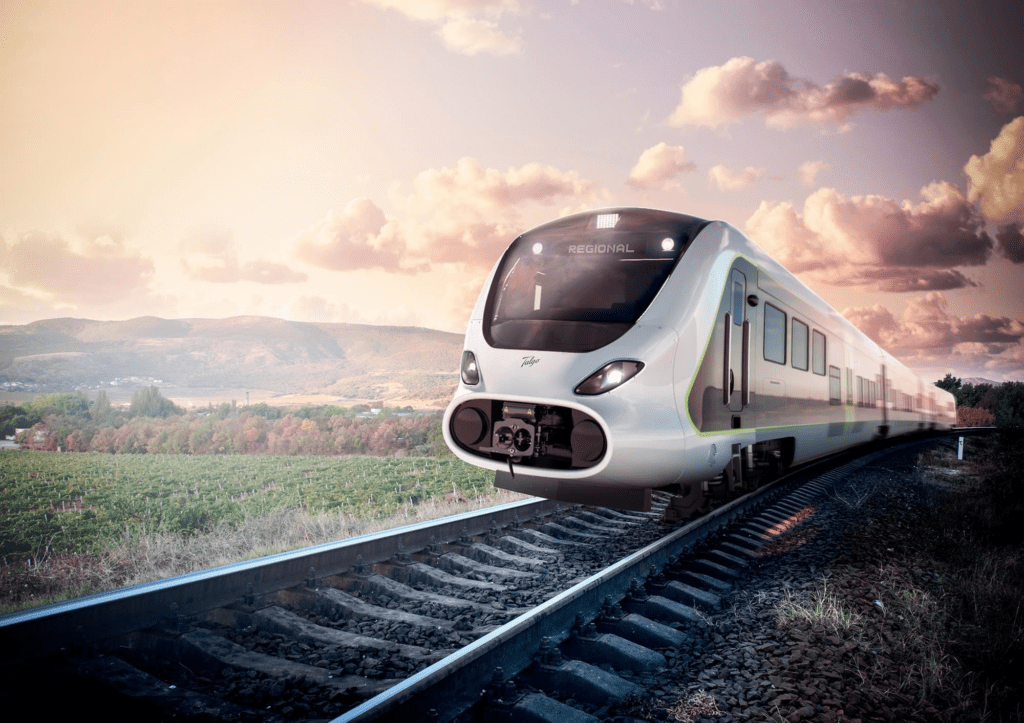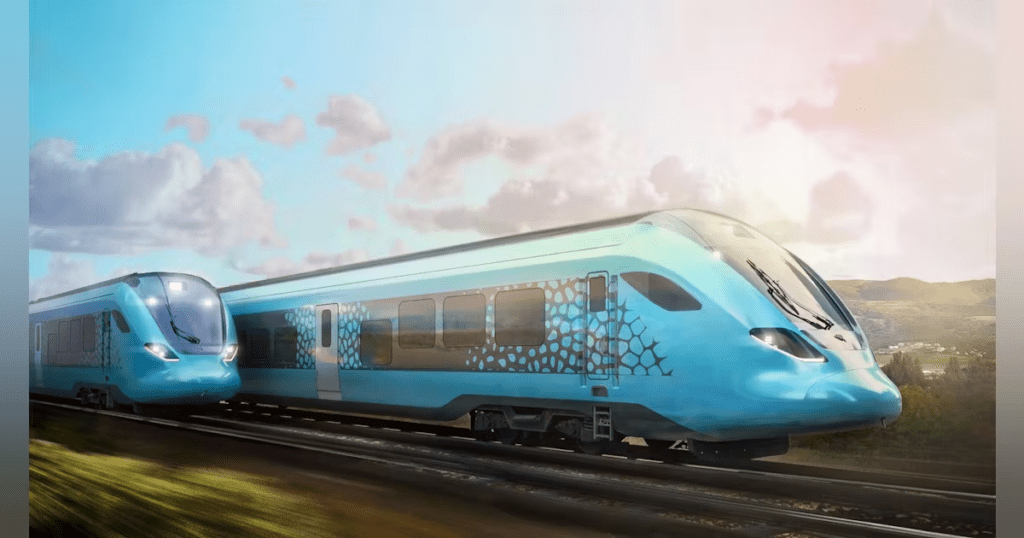As the world seeks innovative solutions to combat climate change, the transportation sector plays a critical role in reducing carbon emissions. One promising advancement in this area is the development of high-speed hydrogen-powered trains, commonly known as hydrail, spearheaded by Spanish train manufacturer Talgo. With its potential to transform rail travel by eliminating the need for overhead wires and drastically cutting emissions, hydrail could be a key piece of the global puzzle to create a more sustainable future.
Hydrail: A Game-Changer in Rail Transport
Hydrogen-powered trains run on fuel cells that combine hydrogen with oxygen from the air, generating electricity to drive the train. This process emits only water vapor as a byproduct, making hydrail a clean and renewable alternative to traditional diesel or electric-powered trains.
One of the significant advantages of hydrail is its ability to operate without relying on overhead electrical wires, which are expensive to install and maintain. This technology allows trains to run efficiently on non-electrified tracks, reducing the infrastructure costs associated with railway expansion. For countries with vast rail networks, where only parts of the system are electrified, hydrogen-powered trains offer an attractive alternative.
Beyond infrastructure savings, hydrail has the potential to significantly cut greenhouse gas emissions. Diesel-powered trains currently produce substantial amounts of CO₂ and other pollutants. Hydrogen, in contrast, can be generated using renewable energy sources like wind or solar power, creating a sustainable energy loop that has the potential to drive rail travel toward carbon neutrality.
Challenges in Implementing Hydrail Technology
Despite its clear benefits, the implementation of hydrogen-powered trains faces several hurdles. The most pressing challenge is the cost and scalability of hydrogen infrastructure. While hydrogen can be produced from water using electrolysis, the process is still energy-intensive and costly. To make hydrogen a viable fuel source for mass rail transit, significant investments must be made in hydrogen production plants, refueling stations, and storage facilities.
Hydrogen storage is another technical challenge. Hydrogen is a low-density gas, which means it requires large tanks or compression to store enough fuel for long journeys. Advances in hydrogen storage technology will be essential to increase the range of hydrail and make it competitive with conventional rail systems.
Furthermore, the price of hydrogen fuel remains relatively high compared to diesel or electricity, especially if hydrogen is produced through non-renewable sources like natural gas. Developing cost-effective and sustainable hydrogen production methods will be key to making hydrail economically viable in the long term.

Opportunities for Climate Action and Energy Transition
The introduction of hydrail comes at a time when the world is increasingly focused on decarbonization and sustainable energy solutions. Rail travel is already one of the most energy-efficient modes of transportation, but hydrogen-powered trains could take this efficiency to the next level.
Energy diversification is another opportunity presented by hydrail technology. In an era where over-reliance on fossil fuels threatens both the environment and energy security, hydrogen offers a versatile and renewable fuel source. Countries that invest in hydrogen infrastructure will not only advance their climate goals but also position themselves as leaders in a global energy transition.
Hydrail can also play a pivotal role in reducing carbon emissions in hard-to-electrify regions. Countries with less developed rail infrastructure or those that cannot afford the costs of full electrification can turn to hydrogen trains as a cost-effective and sustainable alternative. This makes hydrogen-powered rail systems a particularly attractive option for emerging economies looking to modernize their transport systems while adhering to climate commitments.

Proposed Solutions to Overcome the Challenges
To fully realize the potential of hydrail technology, several solutions can help address the current challenges:
- Scaling Renewable Hydrogen Production: Governments and private sector stakeholders must invest in renewable hydrogen production facilities, such as electrolysis plants powered by wind or solar energy. By scaling these technologies, hydrogen production costs will decrease, making it more accessible for widespread use in transportation.
- Hydrogen Storage Innovations: Research and development into advanced hydrogen storage methods, such as liquid hydrogen storage or metal hydrides, will help increase the efficiency of fuel storage and extend the range of hydrail. These innovations will be critical to making hydrogen-powered trains feasible for long-distance travel.
- Hydrogen Infrastructure Investment: The development of a robust hydrogen refueling network, similar to that of electric vehicle charging stations, will be necessary for hydrail to thrive. Governments can play a crucial role by incentivizing the construction of refueling stations and providing subsidies for early-stage development.
- Public-Private Partnerships: Collaboration between governments, private companies, and research institutions is essential to reduce the financial barriers to hydrogen technology. Public-private partnerships can accelerate the deployment of hydrogen-powered trains and facilitate the sharing of resources and expertise across sectors.
- Regulatory Support and Carbon Pricing: Governments can encourage the adoption of hydrail by setting ambitious carbon reduction targets and implementing carbon pricing schemes. By making the environmental costs of diesel and other fossil fuels more explicit, hydrogen-powered transport can become a more competitive alternative.
The Road Ahead for Hydrail
The transition to hydrogen-powered trains is a significant step toward a cleaner, more sustainable future. With the growing need to decarbonize the transport sector, hydrail technology offers a promising solution for reducing emissions while maintaining the efficiency and connectivity of rail travel. However, realizing this potential will require overcoming technical challenges and investing in the infrastructure necessary to support hydrogen as a viable energy source.
As Talgo and other pioneers in the field continue to push the boundaries of rail innovation, hydrail could soon become a common sight on railways around the world, leading the charge toward a greener, more sustainable transportation system. By prioritizing investments in hydrogen technology and fostering international collaboration, the world can take another step closer to achieving its climate goals and mitigating the effects of global warming.
Conclusion
The global race to combat climate change demands bold, innovative solutions like hydrogen-powered rail systems. With Talgo’s hydrail leading the way, this technology offers a transformative opportunity to significantly reduce transportation emissions while addressing energy challenges. By investing in hydrogen infrastructure, supporting technological advancements, and fostering partnerships between governments and industry, the world can accelerate the shift to a sustainable future powered by clean energy.
Related Content
- Spain, World’s First High-Speed Hydrogen Train
- Tesla’s Giga Train: Revolutionizing Public Transit with Ecological Impact
- Researchers devise a novel training method to reduce social biases in AI systems.
- Groundbreaking Achievement: Robot Trained to Read Braille at Twice the Speed of Humans
- Clean Group Enhances Commercial Cleaning Services with New App: Addressing Ecological Considerations
- Tesla: A Balancing Act Between Clean Energy and Production Footprint
- A Planetary Health Check: Crossing Critical Boundaries
- Talgo developing first hydrogen-powered high-speed train
- Talgo to develop hydrogen-powered high-speed train
